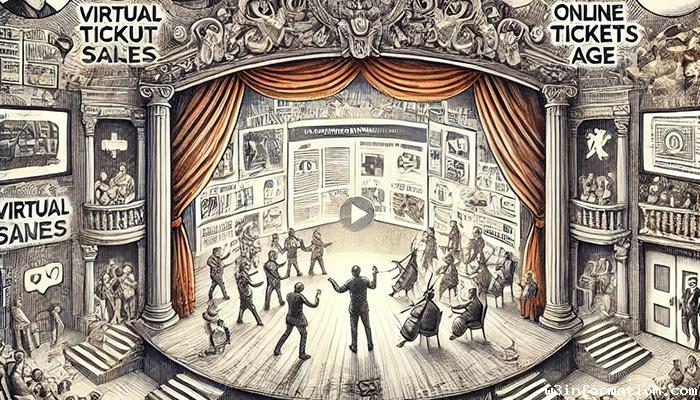How Theater is Thriving in the Digital Age
Live audiences have always been essential for theater because it is one of the oldest and most celebrated performance arts. Digital technology expansion has enabled theater to prosper through innovative and unforeseen methods. The advent of digital technology has revolutionized theater production and audience engagement by allowing artists to broaden their impact and create more interactive experiences. Through the exploration conducted in this blog we see how theater is flourishing during the digital era by merging time-tested traditions with innovative approaches to generate new and exciting experiences.
- Virtual Performances: Breaking Geographical Barriers
- Interactive and Immersive Theater: Engaging the Audience
- Digital theater extends its reach to new audiences through streaming services and digital archives
- Social Media: Building Communities and Expanding Reach
- Hybrid Theater: Combining Live and Digital Experiences
- The Role of Technology in Enhancing Creativity
- Digital Playwriting and Online Collaboration
- More Related Topics
Virtual Performances: Breaking Geographical Barriers
Today's digital advances have opened up theater to wider audiences than ever before. The COVID-19 pandemic hastened theater's transition to virtual performances which required immediate adaptation from theater organizations. A response that started as short-term adaptation has become an enduring element in theatrical productions.
Theatrical groups are using streaming services to deliver live performances directly into homes worldwide. National Theatre Live, BroadwayHD and Digital Theatre+ provide spectators with access to renowned performances from both London’s West End and New York’s Broadway stages. Streaming services enable theater enthusiasts to experience top-notch performances at home no matter where they live.
Virtual performances explore and innovate their presentation formats. Many theater companies today develop their own original digital productions which they create specifically for audiences watching online. Digital productions utilize camera angles, lighting effects and digital editing techniques to push storytelling boundaries beyond traditional theater capabilities.

Interactive and Immersive Theater: Engaging the Audience
Interactive theater techniques combined with immersive digital effects have emerged as major trends in contemporary performance by merging live action with technological components to produce engaging audience experiences. Immersive theater transforms viewers into active participants within the story rather than passive observers as in traditional theater.
The immersive experience heavily relies on advancements in digital technology. Live performances now integrate virtual reality (VR), augmented reality (AR), and projection mapping to develop visually captivating and interactive spaces. Audience participants can wear VR headsets which allow them to enter a digital world where they can engage with both the stage setting and characters throughout the performance.
Live productions incorporate online platforms to facilitate audience participation during performances. In some television shows audiences have the power to make crucial choices which determine how the story progresses. Interactive theater eliminates the conventional separation between performer and audience by giving the latter power to influence the theatrical experience.
Digital theater extends its reach to new audiences through streaming services and digital archives
Digital theater stands out because it lets more people access productions than ever before. The global availability of streaming platforms enables people from different regions to watch plays and performances which would typically be inaccessible. Theater now reaches a more diverse audience including individuals with physical disabilities who reside in distant locations or those who find live performances financially prohibitive.
Digital archives serve as essential tools for preserving theater history alongside streaming services. Theaters are converting their previous performances along with scripts and production materials into online archives for easier access. Digital collections maintain historical theatrical productions while giving future generations access to plays that survive only in digital form.
Digital platforms enable audiences to access theater productions ranging from traditional classics to modern pieces which brings theater to a broader population who might not have previously experienced it.
Social Media: Building Communities and Expanding Reach
Theater companies use social media as an essential platform to establish connections with their audience and cultivate a worldwide network of theater enthusiasts. Theater companies along with actors and playwrights use platforms such as Instagram, Twitter, Facebook, and TikTok to distribute updates and personal narratives alongside behind-the-scenes material to strengthen their bond with audiences.
Theater has adopted social media platforms to enhance its interactive capabilities. Theater spectators have opportunities to connect with performers and directors through real-time interactions while they can pose questions and attend live Q&A sessions. Theater companies utilize their social media channels to host live-streamed events and special announcements together with virtual tours behind-the-scenes to give their fans exclusive insights into theater production.
Social media functions as a marketing tool to promote new productions and draw varied audience groups. Theater organizations that utilize viral marketing along with content produced by their fans can generate excitement about their productions while making theater appealing to technologically savvy younger audiences.
Hybrid Theater: Combining Live and Digital Experiences
The blending of digital components with live theatrical performances represents one of the most thrilling new trends in the theater industry. Hybrid theater productions merge physical attendance with digital participation to deliver a distinctive experience to audiences who engage either live or online.
By integrating live-streaming technology and augmented reality with interactive features into live performances hybrid productions deliver an enhanced and more engaging theatrical experience. A hybrid theater performance allows some audience members to attend the show in person while others view it through a high-definition livestream where they can chat with the cast and vote on aspects of the performance as it unfolds.
Theater companies can extend their audience reach through hybrid theater which provides both physical and virtual viewing options for productions. This approach leads to higher ticket sales while drawing diverse audiences and providing theater access to individuals who would not have the chance to attend otherwise.
The Role of Technology in Enhancing Creativity
Theater artists now have access to technological tools that enable them to explore new dimensions of creativity. Artists now have access to limitless creative opportunities through the use of digital tools such as innovative lighting design and digital projections combined with motion-capture technology and interactive sound design.
Projection mapping stands as a potent instrument in digital theater because it enables artists to project images onto physical structures such as sets and walls. Dynamic visual effects produced by projection mapping turn a basic stage into an elaborate and captivating environment. Stage productions such as "Harry Potter and the Cursed Child" and "The Lion King" have incorporated this technology to produce stunning visual experiences and enchanting moments.
Motion-capture technology enables real-time interaction between digital characters and live performers through digital creation. Current stage productions use this technology and its prevalence is expected to grow with ongoing technological advancements.
Digital Playwriting and Online Collaboration
The digital age has changed traditional theater script development processes. The advent of video conferencing tools, virtual brainstorming platforms, and digital document sharing services has enabled playwrights, directors, and actors to collaborate effortlessly across different geographic locations.
Digital platforms enable theater makers worldwide to join forces across cultural boundaries which results in more varied and inclusive theatrical productions. The rise of virtual playwright festivals and online playwriting competitions lets new writers display their skills worldwide which creates openings for new voices in theater.
Digital playwriting tools including scriptwriting software help writers easily format and revise scripts digitally while enabling streamlined sharing which accelerates creative workflows and collaboration processes.
Conclusion: The digital age presents new possibilities for theater as it continues to thrive with technological advancements.
Digital advancement enables theater to prosper beyond mere survival. Technology enables theater production and experience through virtual performances and interactive theater while digital archiving and social media engagement expands how audiences can enjoy theater. Despite the enduring significance of live performance in theater the digital age provides fresh opportunities for creativity accessibility and audience engagement.
The future of theater depends on combining classical artistic techniques with cutting-edge digital advancements according to current trends in theatrical digital innovation. This new art form combines inclusivity with dynamism and interactivity, captivating and inspiring global audiences. The digital age serves as an exhilarating period for theater which enables both creators and audiences to explore limitless new horizons in performance and storytelling.
 Top 10 Comfort Foods to Try This Winter
Top 10 Comfort Foods to Try This Winter
 Top 10 Christmas Destinations Around the World
Top 10 Christmas Destinations Around the World
 Navigating Adolescence: Tips for Parents and Teens
Navigating Adolescence: Tips for Parents and Teens
 How to Start a DIY Craft Project on a Budget
How to Start a DIY Craft Project on a Budget
 How to Build Strong Family Bonds in the Digital Age
How to Build Strong Family Bonds in the Digital Age
 The Importance of Early Childhood Education
The Importance of Early Childhood Education